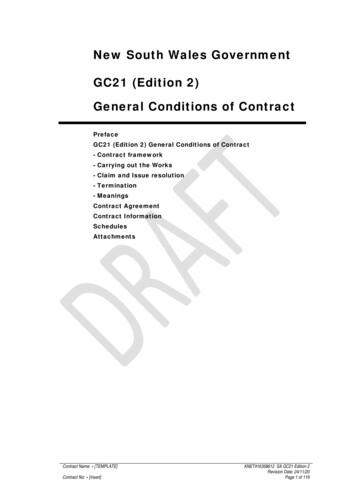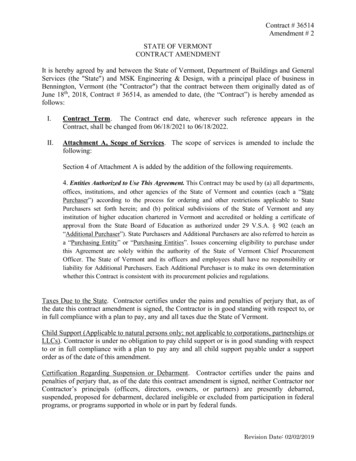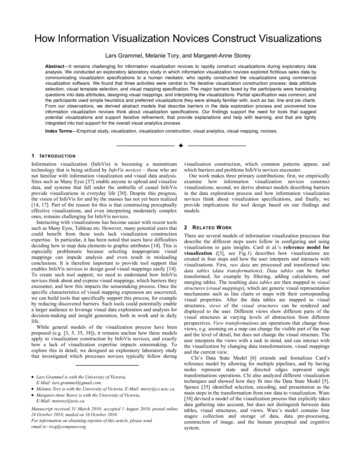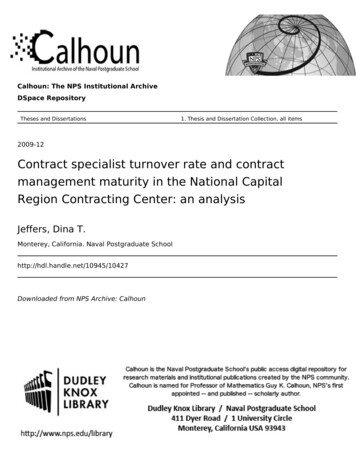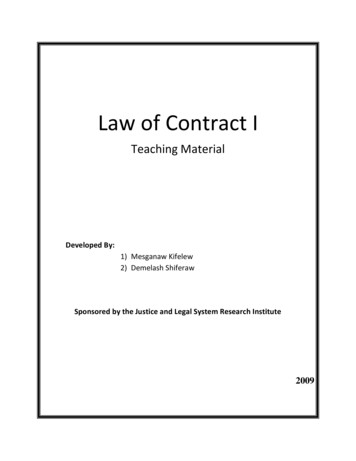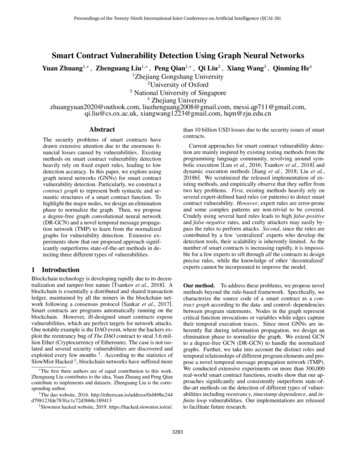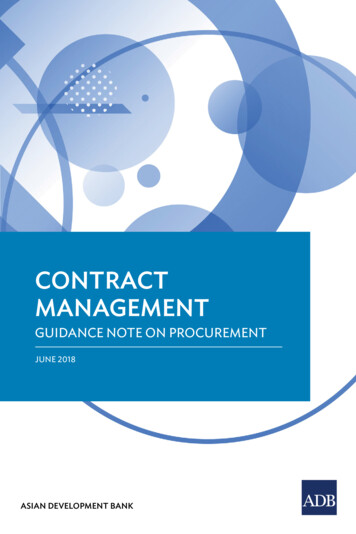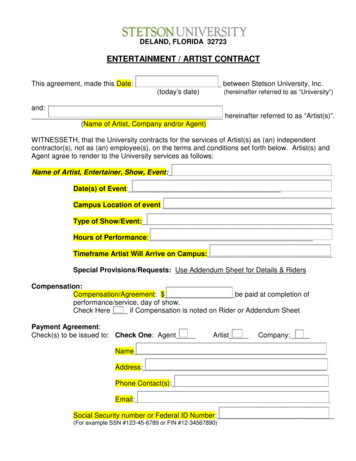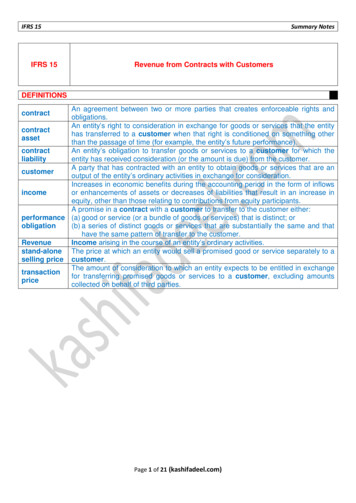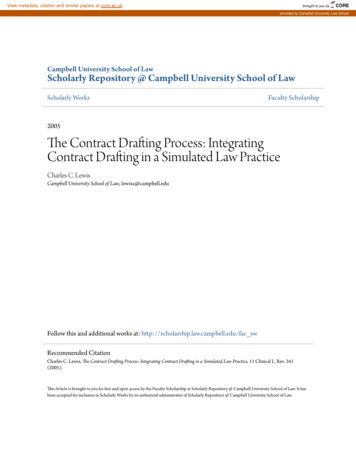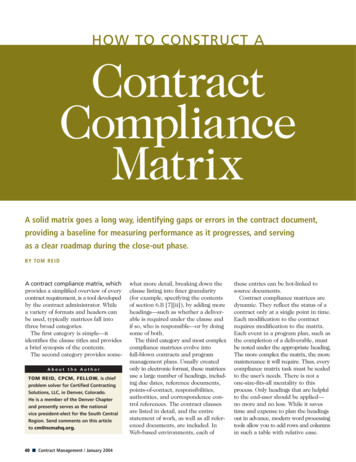
Transcription
HOW TO CONSTRUCT AContractComplianceMatrixA solid matrix goes a long way, identifying gaps or errors in the contract document,providing a baseline for measuring performance as it progresses, and servingas a clear roadmap during the close-out phase.B Y TO M R E I DA contract compliance matrix, whichprovides a simplified overview of everycontract requirement, is a tool developedby the contract administrator. Whilea variety of formats and headers canbe used, typically matrices fall intothree broad categories.The first category is simple—itidentifies the clause titles and providesa brief synopsis of the contents.The second category provides someAbout the AuthorTOM REID, CPCM, FELLOW, is chiefproblem solver for Certified ContractingSolutions, LLC, in Denver, Colorado.He is a member of the Denver Chapterand presently serves as the nationalvice president-elect for the South CentralRegion. Send comments on this articleto cm@ncmahq.org.40 Contract Management / January 2004what more detail, breaking down theclause listing into finer granularity(for example, specifying the contentsof section 6.B [7][ii]), by adding moreheadings—such as whether a deliverable is required under the clause andif so, who is responsible—or by doingsome of both.The third category and most complexcompliance matrices evolve intofull-blown contracts and programmanagement plans. Usually createdonly in electronic format, these matricesuse a large number of headings, including due dates, reference documents,points-of-contact, responsibilities,authorities, and correspondence control references. The contract clausesare listed in detail, and the entirestatement of work, as well as all referenced documents, are included. InWeb-based environments, each ofthese entries can be hot-linked tosource documents.Contract compliance matrices aredynamic. They reflect the status of acontract only at a single point in time.Each modification to the contractrequires modification to the matrix.Each event in a program plan, such asthe completion of a deliverable, mustbe noted under the appropriate heading.The more complex the matrix, the moremaintenance it will require. Thus, everycompliance matrix task must be scaledto the user’s needs. There is not aone-size-fits-all mentality to thisprocess. Only headings that are helpfulto the end-user should be applied—no more and no less. While it savestime and expense to plan the headingsout in advance, modern word processingtools allow you to add rows and columnsin such a table with relative ease.
The “Real-World” ContextA contract compliance matrix servesmany practical purposes. It might beused only by the contracts departmentas a tool to understand the contract,track events in the contract, or trainnew contract administrators. As astand-alone, the matrix can be a usefulresource to help explain contract sections or components to managementor to a customer. It can also be valuable at contract close-out time, as achecklist and tracking tool.More often, however, the creationof a contract compliance matrix is thefirst step toward a contract managementplan. Using the matrix to establish thevarious contract requirements allowsyou to offer input to the programmanager on those portions of hisresponsibilities that must be fulfilledunder the contract. This presents thebaseline for discussions on whospecifically will track the fulfillmentof those requirements. Once thoseissues are settled, you can develop acomplete contract management planfor inclusion in the master programmanagement plan. From these documents the customer will generallydevelop a contractor surveillanceplan, specifying details on contractoversight and performance measurement. It all starts here.Ideally, the contract complianceactivity starts when the request forproposal (RFP) is received, and arequirements traceability matrix (RTM)is developed to ensure that all RFPrequirements are being addressed.While there are significant similaritiesbetween a RTM and a contract compliance matrix, they are fundamentallydifferent. The RTM is set against a relatively fixed document with a verylimited life span. “Performance” underthe proposal is straightforward—respond to the RFP.The contract compliance matrixwill most likely become far moredynamic, and the amount of information necessary to be a fully functionaltool for contract management can farexceed the data necessary in an RTM.Still, a quality RTM is an excellentstarting point to create a contractcompliance matrix. Most commonly,however, no RTM exists, and the contract compliance matrix must be createdfrom “whole cloth,” so to speak.The ProcessThe starting point is always the contract.The contract must be gathered in asingle location and read from beginningto end. Every modification should begathered into the contract file as well.This same approach applies to both thehard- and soft-copy contract formats.It will often be necessary to gather thereference documents into the samefile location. Only with a fundamentalgrasp of the nature and complexity ofthe entire contract can you begin todevelop a matrix.The next step is to determine youraudience and what data each stakeholder needs. Compliance matricescan serve a multitude of purposes. Thatis why there is considerable choice inwhat headings you use. In an idealsetting, you would create the matrixusing all possible headings in asearchable database format. Then,January 2004 / Contract Management 41
H O WT OC O N S T R U C TTen Steps to Createa Contract ComplianceMatrix(1) Read the contract.(2) Determine the audienceto establish the appropriateheadings and format.(3) Determine the correctlevel of detail.(4) Enter the data.(5) Capture data for variableheaders and flow-downrequirements.(6) Review contractmodifications.AC O N T R A C TC O M P L I A N C E(8) Actual delivery date;page breaks. This is not an area inwhich to be dogmatic, however—stayin the familiar, comfortable format-zonethat works best for you.Divide sections of the contract inthe matrix with some identifiable,visual break. A shaded block works well.Set up each section of the contractunder a separate heading. Make thefinal document, whether printed oron-screen, as user-friendly as possible.Your next step is to determine thecorrect level of detail for each entryin the table. For a simple matrix, youwill probably only want to include theprime contract document, and forthe specifications you might only say,“Identifies the work requirementsunder the contract.”For more complex matrices andspecific user-tailored needs, it may beappropriate to break out each sectionof the statement of work. Most contractswill incorporate other documents byreference that will be applicable to thecontract in one way or another. Forcompleteness, some or all of these mayneed to be fully analyzed and therequirements contained in them spelledout in the matrix. The key is to makesure you have tailored the complexityof the matrix to the needs of the user.If you make the matrix too simple or toocomplex, the document will be useless.(9) Applicability timeframe;The Programsure that a matrix—of any sort—isdeveloped. If the client is only comfortable with a simple matrix, preparethat. As noted earlier, columns androws can be added later.Headers come in two basic flavors.“Fixed headers” are those that willappear in all matrices. Typically, thosewill be the headings such as “clausenumber,” “clause name,” and “contents”or “description.” These headers areapplicable to the simplest of matrices.For more complex versions, anynumber of “variable headers” can beused. These come in as many variationsas you and your client can imagine.Popular additional headers include:(1) Deliverables;(2) Responsible organization/person;(7) Add disclaimers.(8) Proofread, proofread,proofread.(9) Distribute for commentbefore going “final.”(10) Keep the matrix current.(3) Referenced documents;(4) Documents incorporatedby reference;(5) Customer point-of-contact;(6) Due date;you would selectively print versionscontaining only the headings necessary for a particular application. Forexample, a matrix might be useful fortracking the funding modifications.But, there could also be reasons whyyou would not want the funding information to be widely disseminated.While the data could reside in thematrix, you would only print thatcolumn of data on those versionsbeing distributed to those who needto know this kind of information.Next, you will want to establish thematrix headings. Detailed interviewsshould be held with the client to understand their needs and their interests.If they have never used a matrix andfound what a functional tool it can be,you may have to share some examples.Do not undersell the need for continuedmaintenance, but do not oversell theneed for complexity in a simple contract. The scope must be sized to youruser’s specific needs. At this stage, themore important aspect is to make42 Contract Management / January 2004M A T R I X(7) Reporting date;(10) Correspondence controlreference number;(11) Links to other databases; and(12) Required format for eachdeliverable.Next, format the document in whatever software you are using. While thetemptation is to use a spreadsheet,experience has shown that usingtables in a word processing programworks best. For one thing, you willhave a lot of words, and most spreadsheet programs do not do spell-checkautomatically. Also, tables usuallyprovide you with greater flexibility inmore readable cell sizes and formattedNow, it is time to enter the data. In aworst-case scenario, you may have totype it all in longhand. If so, be sureto have a separate set of eyes proofread your data entry. If you haveaccess to a soft copy of the contract,you will be able to cut and paste thesections where they belong.Be careful—a matrix is useless if allit does is take the entire contents ofa contract and format it in columns.The “contents” or “description” section needs to be a readable synopsisof the contract, not all of the legalese.Remember: Your user is most likely abusiness executive or a program manager. They expect you to know whatthe contract says in detail. All theyneed is a brief description to understand the thrust of a clause. Even for
H O WT OC O N S T R U C TAC O N T R A C TC O M P L I A N C EM A T R I XSample Compliance Matrix (Simple) FormatClause #TitleDescriptionSECTION A: SF1449NoneSolicitation, Offer, andAwardStandard form used to award a contract.SECTION B: SUPPLIES OR SERVICES AND PRICES/COSTSB.1Services Being AcquiredProvides the basic nature of the services to be provided and requires[state the general nature of the work to be performed].B.2Estimated Cost and FeeStates that the estimated cost under this contract is ,and the potential fee is .B.3Availability ofAppropriated FundsProvides that there are no funds available for this procurement and states thatthe government will notify party when there are. It also cautions against beginning work before funds are available. Any action on the part of the contractormay not be reimbursed.B.4Obligation of FundsSets forth the amount of funds obligated under the contract as modifiedfrom time to time.SECTION C: DESCRIPTION / SPECIFICATION / WORK STATEMENTC.1General InformationSets forth the basic requirements under the contract.C.2Statement of WorkSets forth specific requirements. See program plan for details available fromthe program manager.C.3DeliverablesSpecifies deliverables the customer is expecting to see and due dates for each.Refer to program plan.SECTION D: PACKAGING AND MARKINGD.1Packaging and MarkingRequires use of standard commercial practices in packing and marking shipments.It includes an additional requirement to specify the contract number and COR inall addresses.SECTION E: INSPECTION AND ACCEPTANCEE.1Inspection Of Services—Cost Reimbursement(FAR 52.246-5) (APR 1984)Standard FAR clause—establishes the government’s right to inspect all servicescalled for by the contract at all places and times.E.2AcceptanceAcceptance of all work is by the contracting officer or duly authorized representative.SECTION F: DELIVERIES OR PERFORMANCEF.1Term of ContractEstablishes the contract term of one year with two options.F.2Option to Extend theTerm of the ContractAllows the government to extend the term of the contract with 30-days notice,as long as intent was communicated at least three months before expiration.F.3Stop-Work Order FAR52.242-15 (AUG 1989)Alternate I (APR 1984)Standard FAR clause—establishes the government’s right to issue a written orderfor the contractor to stop all or any part of the work under the contract. Thecontracting officer shall make an equitable adjustment (e.g., delivery schedule,estimated cost, fee, etc.) as appropriate.Table 1. Compliance Matrix for Contract No. 123-4546-789 ABC, Inc., for U.S. GovernmentJanuary 2004 / Contract Management 43
H O WT OC O N S T R U C Tyour own use, the brief descriptionshould allow you to peruse the matrixand quickly hone in on a particularsection. Too many words, especiallyused verbatim, and you have defeatedthe purpose of the matrix.As you enter this data, it may bethe right time to capture the information for the variable headers. This willdepend on what information you haveavailable and what responsibilityassignments have already been made.If necessary, begin sharing drafts ofseveral pages of the matrix with theclient and determining the variousresponsibilities. If due dates are partof the variable headings, make the datain the cell useful. While “30 days ADC”may make perfect sense to us, go aheadand calculate the date, so it says,specifically, “Due on June 10, 2004.”In all cases, you should capture theflow-down requirements. One effectiveway to note them is to use the highlighting function available in most wordprocessing programs. Alternatively,you can highlight the requirement byusing a different color text. Make iteasy for the procurement folks tocomply with the contract.Be certain to review each of thecontract modifications. If there arenot very many of them, do the entirecontract and then add in the modifications. If the modifications areextensive, it might be useful to createa conformed version of the contractbefore starting. Otherwise, you willbe entering a great deal of data at thebeginning that will later be replaced.Be extremely careful about when contract provisions are applicable. Evenif a contract clause has been replacedor removed, it is possible that at somepoint in performance that languagewas controlling. For this reason, it issometimes practical to add a heading,indicating the period of applicabilityfor certain clauses.In larger cost-type contracts, youwill have a considerable number offunding modifications. If that is trulyall that appears, there is generally nouseful purpose in trying to capturethem in a matrix. Finance shouldhave their own mechanism for identi44 Contract Management / January 2004AC O N T R A C TC O M P L I A N C Efying the funds on the contract, thebilling schedule, and the paymentschedule. In simpler contracts, however, especially in smaller companies,including this data in the matrix maybe valuable and may, in fact, be theonly location for such information.Make sure you add appropriate disclaimers. Most businesses will want tokeep compliance matrix data confidential. This is particularly true withcertain headings of information.Whether a deliverable has been meton time is not necessarily publicinformation. Highlighting the fact thatthere are deliverables required underyour contract that have never beendelivered is also a sensitive subject.Consequently, your legal and generalmanagement departments will havean opinion on what data gets released.Use the appropriate legend that yourcompany prescribes.Additionally, always includea disclaimer. Here is an exampleof language to use:This document is a working tool for usein managing the subject contract. Whilebelieved accurate, only the contractdocument contains the full and completeagreement between the parties. While thismatrix may provide general guidance, itshould not be relied on for detailed interpretations of the contract language or therights or responsibilities of either (or any)party. When in doubt, read the contract.For additional guidance, please contact thecontracts department (or legal, or both).Each page of the matrix should thencontain a reminder in the footer, suchas, “This document is subject to thelimitations contained on the cover.This is a synopsis. Rely only on theofficial contract document for completeaccuracy.” You should also be sure toinclude whatever proprietary markingyour management has requested, asdiscussed previously.Reality Check: ProofreadGet several sets of eyes on the matrix.Find a detail-oriented copy editor.Do whatever it takes to make surethat the matrix is validated againstM A T R I Xthe contract. While considerable judgment will be applied in synopsizingthe contents of clauses, always keepin mind that the goal of the matrixis to be a useful tool in contract management. Too much or too littleinformation will not do—find thehappy medium.Distribute a draft for comment.Depending on your organization, thatmay include a large staff of 30 or oneor two key people. Ask them whatthey find helpful and what else theywould like to see. Emphasize that it isa living document and designed to bean effective tool. You may be the onlyperson in your entire organizationthat has ever read the entire contract.(Let’s say that if there is only oneperson in your organization who hasdone so, it had better be you!) Butevery manager and every personresponsible for a deliverable, however,needs to know what is required.It is your job to translate.Finally, make certain that thematrix is kept current. While thistakes some attention, an outdatedmatrix is useless and wastes the timeinvested in creating it. Once youhave one developed, be faithful inmaintaining it. For a good example,see the chart on page 43.Using the “Sight”A solid matrix goes a long way towardidentifying gaps or errors in the contract document, providing a baselinefor measuring performance as itprogresses, and serving as a clearroadmap during the close-out phase.A well-prepared contract compliancematrix is an incredibly useful toolfor contract administrators.Once you are accustomed to a matrix,you will wonder how you ever managed without one. The simple exerciseof preparing a matrix will familiarizeyou with the contract like no otherexercise. And, when you can go backto your customer with helpful information about gaps in the contract orcan remind a manager of a due datebefore it is past, you will becomethe hero in their eyes that the restof us already know that you are! CM
TOM REID, CPCM, FELLOW,is chief problem solver for Certified Contracting Solutions, LLC, in Denver, Colorado. He is a member of the Denver Chapter and presently serves as the national vice president-elect for the South Central Region. Send comments on this article to cm@ncmahq.org. About the Author
